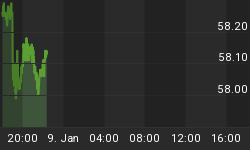Gold and precious metal shares sold off on Tuesday and Wednesday. Yet, I am still of the opinion that the fundamental and technical dynamics are intact for higher prices, and I would not view this sell off as a reversal in the trend.
Over the last month, I have tried to make the case as to why gold, gold shares and hard assets in general were going higher. My argument in a nutshell was that this was not due to economic expansion, as in commodities are leading the recovery and there is higher end user demand, but that higher precious metal prices were the result of a falling, de-valued dollar. Furthermore, as the economic expansion putters along, the Federal Reserve would only add fuel to the fire by a continued accommodative stance. Lower interest rates and creation of paper dollars is a strong recipe for higher prices in hard assets.
But to take this analysis a step further, let's ask the following question: what is going to keep rates low? First you must accept the following premise: it has been the American consumer's consumption based upon a rising tide of liquidity that has kept the stock market buoyant. Yet it is the consumer that is clearly threatened by this economic slow down.
Job creation? Anemic.
Rising energy costs? Certainly putting a crimp in discretionary spending.
Refinancing boom? Not if housing prices have peaked.
Rising rates with an already stressed consumer? Not likely.
Figure 1 is a weekly chart of the Morgan Stanley Consumer Index. First note the triple top (points 1,2,3); then note the break of the up trend line (points AB). Once support was broken, this trend line has acted as resistance. A significant down thrust is at point C and a close below this level would seal the down trend. If this chart is a measure of consumer health, then the patient is not doing too well.
Figure 1. Morgan Stanley Consumer Index/weekly
I cannot see the Federal Reserve raising rates with the consumer so perilously perched at the financial abyss of despair. If rates are not headed higher, then these accommodative policies should be both inflationary and serve to de-value the dollar. This is good for hard assets.
As I see it, the fundamental story for precious metals is still intact.
If you would like more on gold and the technical picture, please visit www.thetechnicaltake.com.
















